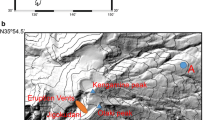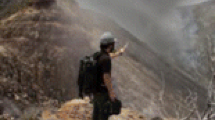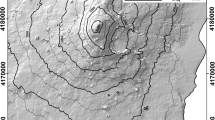Abstract
Airborne measurements of volcanic gas composition using an unmanned aerial vehicle (UAV) and Cessna aircraft were conducted at Kuchinoerabujima volcano, Japan, between 2014 and 2016. Because eruptions occurred in August 2014, May 2015, and June 2015, access to the summit crater was limited because of the risk of sudden eruption such that airborne measurements were the only viable method to measure the volcanic gas composition. Multi-GAS and alkali-filter pack measurements were made on the leeward side of the crater and around the crater, using the Cessna and UAV, respectively. Observations using the UAV could measure the dense plume and quantify the gas species of H2O, CO2, SO2, H2S, H2, HCl, and HF, while the observations using the Cessna could measure only the diluted plume and quantify CO2, SO2, H2S, and H2. The seven airborne observations enabled us to monitor variations in the volcanic gas composition. Over the observation period, the SO2/H2S ratio decreased from 10 to 1.9. The H2O/SO2 ratio, H2/SO2 ratio, and apparent equilibrium temperatures (AET) estimated using the volcanic gas composition increased after the 2014 eruption. The decrease in the SO2/H2S ratio might be attributed to changes in the pressure of degassing magma and interactions with the hydrothermal system. The airborne methods presented here highlight the utility of using light aircrafts to safely conduct volcanic gas measurements during periods of volcanic unrest when traditional ground-based methods are not possible.






Similar content being viewed by others
References
Aiuppa A, Federico C, Paonita A, Percoraino G, Valenza M (2002) S, Cl and F degassing as an indicator of volcanic dynamics: the 2001 eruption of Mount Etna. Geophys Res Lett 29(11):1559. https://doi.org/10.1029/2002GL015032.
Aiuppa A, Federico C, Giudice G, Gurrieri S (2005) Chemical mapping of a fumarolic field: La Fossa crater, Vulcano Island (Aeolian Islands, Italy). Geophys Res Lett 32:L13309. https://doi.org/10.1029/2005GL023207
Allard P, Carbonnelle J, Dajlevic D, Le Bronec J, Morel P, Robe MC, Maurenas JM, Faivre-Pierret R, Martin D, Sabroux JC, Zettwoog P (1991) Eruptive and diffuse emissions of CO2 from Mount Etna. Nature 351:387–391. https://doi.org/10.1038/351387a0
Burgisser A, Scaillet B (2007) Redox evolution of a degassing magma rising to the surface. Nature 445:194–197. https://doi.org/10.1038/nature05509
Burton M, Oppenheimer C, Horrocks LA, Francis PW (2001) Diurnal changes in volcanic plume chemistry observed by lunar and solar occultation spectroscopy. Geophys Res Lett 28:843–846. https://doi.org/10.1029/2000GL008499
Burton MR, Allard P, Mure F, Spina LA (2007) Magmatic gas composition reveals the source depth of slug-driven Strombolian explosive activity. Science 317:227–230. https://doi.org/10.1126/science.1141900
Christenson BW, Reyes AG, Young R, Moebis A, Sherburn S, Cole-Baker J, Britten K (2010) Cyclic processes and factors leading to phreatic eruption events: insights from the 25 September 2007 eruption through Ruapehu crater lake, New Zealand. J Volcanol Geotherm Res 191:15–32. https://doi.org/10.1016/j.jvolgeores.2010.01.008
de Moor JM, Fischer TP, Sharp ZD, King PL, Wilke M, Botcharnikov RE, Cottrell E, Zelenski M, Mafty B, Klimm K, Rivard C, Ayalew D, Ramirez C, Kelly KA (2013) Sulfur degassing at Erta Ake (Ethiopia) and Masaya (Nicaragua) volcanoes: implications for degassing processes and oxygen fugacities of basaltic systems. Geochem Geophys Geosyst 14(10):4076–4108. https://doi.org/10.1002/ggge.20255
de Moor JM, Aiuppa A, Avard G, Wehrmann H, Dunbar N, Muller C, Tamburello G, Giudice G, Liuzzo M, Moretti R, Conde V, Galle B (2016) Turmoil at Turrialba volcano (Costa Rica): degassing and eruptive processes inferred from high-frequency gas monitoring. J Geophys Res Solid Earth 121:5761–5775. https://doi.org/10.1002/2016JB013150
Francis P, Maciejewski A, Oppenheimer C, Chaffin C, Caltabiano T (1995) SO2-HCl ratios in the plumes from Mt. Etna and Vulcano determined by Fourier-transform spectroscopy. Geophys Res Lett 22:1717–1720
Galle B, Oppenheimer C, Geyer A, McGonigle AJS, Edmonds M, Horrocks L (2002) A miniaturised ultraviolet spectrometer for remote sensing of SO2 fluxes: a new tool for volcano surveillance. J Volcanol Geotherm Res 119:241–254
Gerlach TM (1993) Thermodynamic evaluation and restoration of volcanic gas analyses: an example based on modern collection and analytical methods. Geochem J 27:305–322
Gerlach TM, Delgado H, McGee KA, Doukas MP, Venegas JJ, Cardnas L (1997) Application of the LI–COR CO2 analyzer to volcanic plumes: a case study, Volca’n Popocate’petl, Mexico, June 7 and 10, 1995. J Geophys Res 102:8005–8019. https://doi.org/10.1029/96JB03887
Geshi N, Iguchi M, Shinohara H (2016) Phreatomagmatic eruptions of 2014 and 2015 in Kuchinoerabujima volcano triggered by a shallow intrusion of magma. J Nat Dis Sci 37(2):67–78
Giggenbach WF (1987) Redox processes governing the chemistry of fumarolic gas discharges from White Island. New Zealand. Appl Geochem 2:143–161
Giggenbach WF, Goguel RL (1989) Collection and analysis of geothermal and volcanic water and gas discharges. Chem Div DSIR Rept CD 2401:81
Giggenbach WF, Matsuo S (1991) Evaluation of results from second and third IAVCEI field workshops on volcanic gases, Mt Usu, Japan, and White Island, New Zealand. Appl Geochem 6:125–141
Harris A (2013) Thermal remote sensing of active volcanoes a user’s manual. Cambridge University Press, New York
Hashimoto T, Koyama T, Kaneko T, Ohminato T, Yanagisawa T, Yoshimoto M, Suzuki E (2014) Aeromagnetic survey using an unmanned autonomous helicopter over Tarumae volcano, northern Japan. Explor Geophys 45:37–42
Horton KA, Williams-Jones G, Garbeil H, Elias T, Sutton AJ, Mouginis-Mark P, Porter JN, Clegg S (2006) Real-time measurement of volcanic SO2 emissions: validation of a new UV correlation spectrometer (FLYSPEC). Bull Volcanol 68:323–327
Iguchi M (2007) Volcanic activity at Kuchinoerabujima volcano in 2006. In: Iguchi M (ed) Practical study on prediction of phreatic eruption and its change at Kuchinoerabujima volcano, Japan. DPRI, Kyoto University, pp 1–8 (in Japanese)
Iguchi M, Nakamichi H, Tameguri T, Yamamoto K, Mori T, Ohminato T, Saito E (2017) Contribution of monitoring data to decision making for evacuation from the 2014 and 2015 eruptions of Kuchinoerabujima volcano. J Nat Dis Sci
Japan Meteorological Agency (2013) Major eruptive activities in Japan in 2013, in “annually report on earthquakes and volcanoes in Japan, December 2013”
Japan Meteorological Agency (2014) Major eruptive activities in Japan in 2014, in “annually report on earthquakes and volcanoes in Japan, December 2014”
Japan Meteorological Agency (2015) Major eruptive activities in Japan in 2015, in “monthly report on earthquakes and volcanoes in Japan, May 2015”
Kaneko T, Koyama T, Yasuda A, Takeo M, Yanagisawa T, Kajiwara K, Honda Y (2011) Low-altitude remote sensing of volcanoes using an unmanned autonomous helicopter: an example of aeromagnetic observation at Izu-Oshima volcano, Japan. Int J Remote Sens 32:1491–1504. https://doi.org/10.1080/01431160903559770
Kazahaya R, Shinohara H, Mori T, Iguchi M, Yokoo A (2016) Pre-eruptive inflation caused by gas accumulation: insight from detailed gas flux variation at Sakurajima volcano, Japan. Geophys Res Lett 43:11219–11225
Koyama T, Kaneko T, Ohminato T, Yanagisawa T, Watanabe A, Takeo M (2013) An aeromagnetic survey of Shinmoe-dake volcano, Kirishima, Japan, after the 2011 eruption using an unmanned autonomous helicopter. Earth Planets Space 65:657–666
Kusakabe M, Komoda Y, Takano B, Abiko T (2000) Sulfur isotopic effects in the disproportionation reaction of sulfur dioxide in hydrothermal fluids: implications for the d 34S variations of dissolved bisulfate and elemental sulfur from active crater lakes. J Volcanol Geotherm Res 97:287–307
Li Y, Deng J, Mu C, Xing Z, Du K (2014) Vertical distribution of CO2 in the atmospheric boundary layer: characteristics and impact of meteorological variables. Atmos Environ 91:110–117
Macdonald GA (1972) Volcanoes. Prentice Hall, Englewood Cliffs
McGonigle AJS, Aiuppa A, Giudice G, Tamburello G, Hodson AJ, Gurrieri S (2008) Unmanned aerial vehicle measurements of volcanic carbon dioxide fluxes. Geophys Res Lett 35:L06303. https://doi.org/10.1029/2007GL032508
Miyagi I, Maeshima M (2012) Estimation of eruptive temperatures based on the color data of digital cameras. Bull Volc Soc Japan 57:45–50
Mori T, Notsu K, Tohjima Y, Wakita H (1993) Remote detection of HCl and SO2 in volcanic gas fromUnzen volcano, Japan. Geophys Res Lett 20:1355–1358
Mori T, Hirabayashi J, Kazahaya K, Mori T, Ohwada M, Miyashita M, Iino H, Nakahori Y (2007) A compact ultraviolet spectrometer system (COMPUSS) for monitoring volcanic SO2 emission: validation and preliminary observation. Bull Volc Soc Japan 52:105–112
Mori T, Hashimoto T, Terada A, Yoshimoto M, Kazahaya R, Shinohara H, Tanaka R (2016) Volcanic plume measurements using a UAV for the 2014 Mt. Ontake eruption. Earth Planets Space 68:49. https://doi.org/10.1186/s40623-016-0418-0
Mori T, Morita M, Iguchi M, Headquarters FR (2017) Sulfur dioxide flux monitoring using a public ferry after the 2014 eruption of Kuchinoerabujima volcano, Japan. J Nat Dis Sci 38(1):105–118
Ohba T, Hirabayashi J, Yoshida M (1994) Equilibrium temperature and redox state of volcanic gas at Unzen volcano, Japan. J Volcanol Geotherm Res 60:263–272
Ohminato T, Kaneko T, Koyama T, Watanabe A, Kanda W, Tameguri T, Kazahaya R (2017) Unmanned observations in an area in danger of volcanic eruptions by using an UAV at Kuchinoerabu-jima volcano, southern Kyushu, Japan. J Nat Dis Sci 38(1):85–104
Pieri D, Diaz JA, Bland G, Fladeland M, Madrigal Y, Corrales E, Alegria O, Alan A, Realmuto V, Miles T, Abtahi A (2013) In situ observations and sampling of volcanic emissions with NASA and UCR unmanned aircraft, including a case study at Turrialba volcano, Costa Rica. Geol Soc Lond, Spec Publ 380:SP380–SP313
Rüdiger J, Tirpitz JL, de Moor JM, Bobrowski N, Gutmann A, Liuzzo M, Ibarra M, Hoffmann T (2018) Implementation of electrochemical, optical and denuder-based sensors and sampling techniques on UAV for volcanic gas measurements: examples from Masaya, Turrialba and Stromboli volcanoes. Atmos Meas Tech 11(4):2441–2457
Shinohara H (2005) A new technique to estimate volcanic gas composition: plume measurements with a portable multi-sensor system. J Volcanol Geotherm Res 143:319–333. https://doi.org/10.1016/j.jvolgeores.2004.12.004
Shinohara H (2013) Composition of volcanic gases emitted during repeating Vulcanian eruption stage of Shinmoedake, Kirishima volcano, Japan. Earth Planets Space 65:667–675
Shinohara H, Witter JB (2005) Volcanic gases emitted during mild Strombolian activity of Villarica volcano, Chile. Geophys Res Lett 32:L20308. https://doi.org/10.1029/2005GL024131
Shinohara H, Kazahaya K, Saito G, Fukui K, Odai M (2003) Variation of CO2/SO2 ratio in volcanic plumes of Miyakejima: stable degassing deduced from heliborne measurements. Geophys Res Lett 30(23). https://doi.org/10.1029/2002GL016105.
Shinohara H, Aiuppa A, Giudice G, Gurrieri S, Liuzzo M (2008) Variation of H2O/CO2 and CO2/SO2 ratios of volcanic gases discharged by continuous degassing of Mount Etna volcano, Italy. J Geophys Res 113:B09203
Shinohara H, Hirabayashi J, Nogami K, Iguchi M (2011a) Evolution of volcanic gas composition during repeated culmination of volcanic activity at Kuchinoerabujima volcano, Japan. J Volcanol Geotherm Res 202:107–116
Shinohara H, Matsushima N, Kazahaya K, Ohwada M (2011b) Magma-hydrothermal system interaction inferred from volcanic gas measurements obtained during 2003-2008 at Meakandake volcano, Hokkaido, Japan. Bull Volcanol 73(4):409–421. https://doi.org/10.1007/s00445-011-0463-2
Sostman HE, Metz PD (1995) Fundamentals of thermometry part VIII radiation thermometry and calibration. Isotech J Thermometry 6(2):74–86
Stix J, de Moor JM (2018) Understanding and forecasting phereatic eruptions driven by magmatic degassing. Earth Planets Space 70:83. https://doi.org/10.1186/s40623-018-0855-z
Stix J, de Moor JM, Rüdiger J, Alan A, Corrales E, D'Arcy F, Diaz JA, Liotta M (2018) Using drones and miniaturized instrumentation to study degassing at Turrialba and Masaya volcanoes, Central America. J Geophys Res Solid Earth 123:8. https://doi.org/10.1029/2018JB015655
Werner C, Hurst T, Scott B, Sherburn S, Christenson BW, Britten K, Cole-Baker J, Mullan B (2008) Variability of passive gas emissions, seismicity, and deformation during crater lake growth at White Island volcano, New Zealand, 2002-2006. J Geophys Res 113:B01204. https://doi.org/10.1029/2007JB005094
Xi X, Johnson MS, Jeong S, Fladeland M, Pieri D, Diaz JA, Bland GL (2016) Constraining the sulfur dioxide degassing flux from Turrialba volcano, Costa Rica using unmanned aerial system measurements. J Volcanol Geotherm Res 325:110–118
Acknowledgements
We thank Yamaha Motor Co., Ltd. and New Japan Aviation Co., Ltd. for their technical support in the field operation. We are grateful to Atsushi Watanabe, Takao Koyama, and Wataru Kanda for the help during the UAV surveillance. We appreciate invaluable comments from Emma Liu, John Stix, Taryn Lopez, and Maarten deMoor to improve this manuscript. We thank Toshiya Mori and Genji Saito for providing flux and melt inclusion data.
Funding
This work was supported by JSPS KAKENHI Grant number JP16K01320, JSPS KAKENHI Grant number 26287103, and MEXT KAKENHI Grant Number 15H05794.
Author information
Authors and Affiliations
Corresponding author
Additional information
Editorial responsibility: P. Allard
Electronic supplementary material
ESM 1
(DOCX 1.48 mb)
Rights and permissions
About this article
Cite this article
Kazahaya, R., Shinohara, H., Ohminato, T. et al. Airborne measurements of volcanic gas composition during unrest at Kuchinoerabujima volcano, Japan. Bull Volcanol 81, 7 (2019). https://doi.org/10.1007/s00445-018-1262-9
Received:
Accepted:
Published:
DOI: https://doi.org/10.1007/s00445-018-1262-9




